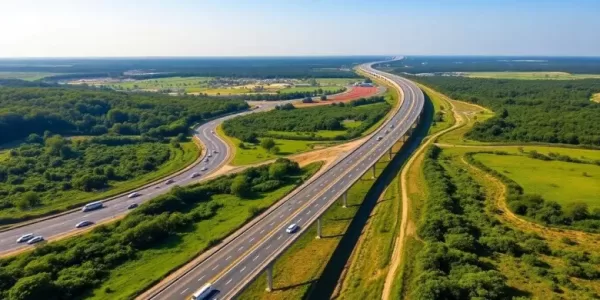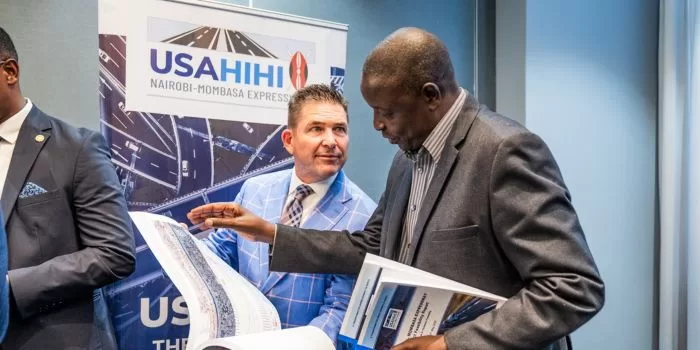In a major development, United States-based firm Everstrong Capital has submitted a feasibility study for the Usahihi Expressway project. The 2,300-page document was submitted to the Kenya National Highways Authority (KeNHA) on Monday evening. The study covers various scopes of the project’s implementation. These include technical, financial, legal, social, and environmental aspects of the project. The study, according to Everstrong, is a shift from concept to implementation.
The firm also described it as the most transparent and extensive infrastructure proposal in Kenya’s history. While meeting with KeNHA, Everstrong Senior Advisor Kyle McCarter guaranteed total compliance with Kenya’s Public-Private Partnership policy. Furthermore, he disclosed that the firm is sourcing Ksh466 billion ($3.6 billion) for the expressway. Construction will begin in early 2026. On completion, travel from Nairobi to Mombasa will be cut from 10.5 to 4.5 hours. The Usahihi Expressway will also boost trade, create jobs, and improve regional security and connectivity. It is a landmark for Kenya and Africa.
Also read:
Usahihi Expressway Construction to Commence Next Year, Africa’s Largest Toll Road Project
Project Factsheet
Developer: Usahihi Expressway Limited, backed by US-based Everstrong Capital.
Route: The expressway will run alongside the existing Nairobi-Mombasa highway.
Length: Approximately 440 kilometers.
Lanes: It will be a dual carriageway, with the number of lanes varying (potentially four to six lanes in total).
Estimated total cost: Approximately $3.5 – $3.6 billion (KES 452 – KES 468 billion).
Funding:
- Everstrong Capital aims to raise KES 129 billion ($1 billion) from domestic pension funds and financial institutions.
- An additional KES 323 billion ($2.5 billion) is targeted from international investors.
- The project is structured as a Public-Private Partnership (PPP) using a Build-Operate-Transfer (BOT) model over a 30-year concession period.
Expected timeline:
- Feasibility study is expected to be completed by May 2025.
- Construction is expected to commence in early 2026.
- Also, construction is projected to take approximately four years.
Key features and benefits:
- Reduced travel time: Expected to cut travel time between Nairobi and Mombasa from the current 10+ hours to approximately 4.5 hours.
- Decongestion: Also intended to decongest the existing Nairobi-Mombasa highway.
- Job creation: Expected to create employment opportunities during the construction and operation phases.
- Toll revenue: Revenue will be generated through toll fees, primarily from heavy commercial vehicles
- Sustainability features: Plans include rest stops, wildlife observation points, electric vehicle charging infrastructure powered by renewable energy. Will also include wildlife overpasses.
The Scope of Implementation on the Usahihi Expressway Project

Approximated at a value of $3.6 billion, the Usahihi Expressway will stretch for 459 kilometers, linking Nairobi to Mombasa. Everstrong termed it a green and equitable model of African infrastructure. Furthermore, it will be one of Africa’s longest toll highway, with wildlife corridors and renewable energy stops. The highway will also feature electric car charging stations. Drivers will pay Ksh12 or Ksh13 per kilometer to use the road, reports indicate. This is cheaper than the Nairobi Expressway at Ksh18 per kilometer. As McCarter put it, the Usahihi Expressway is not a road, it is a paradigm shift in the infrastructure model for the continent.
The Significance of the Project
The implementation of the Usahihi expressway project is expected to serve as a template for subsequent infrastructure development in Africa. McCarter described the Usahihi Expressway as a pioneering project designed to ease traffic congestion. Moreover, it is expected to unlock new avenues of trade and boost regional security. With shorter travel time of only 4.5 hours from Nairobi to Mombasa, the expressway is expected to enhance people and goods movement while increasing Kenya’s economic competitiveness. Thousands of jobs will be generated at the construction stage and operational phases of the project.
Also read:


You’ve set a high standard for depth and readability—thank you!Regards – WebTrafficStore.com